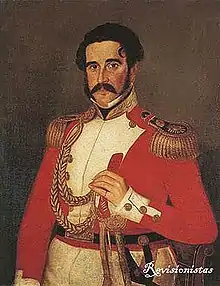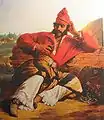Batallón de Voluntarios Rebajados de Buenos Aires
Batallón de Voluntarios Rebajados de Buenos Aires was a 19th-century Argentine military unit.[1] It was a special unit of the Federal Party of active participation during the civil war between federales and unitarios.[2]
| Batallón de Voluntarios Rebajados de Buenos Aires | |
|---|---|
 Colonel Joaquín Ramiro | |
| Disbanded | 1852 |
| Country | Argentina |
| Allegiance | |
| Branch | Argentine Army |
| Type | Infantry |
| Engagements | Batalla de Quebracho Herrado Battle of Costa Brava Sitio de Montevideo Batalla de la Vuelta de Obligado Batalla de Caseros |
History
The Battalion of Volunteers "Rebajados" of Buenos Aires was an infantry unit created in 1840 during the government of Juan Manuel de Rosas. It was formed by veterans of the Brazilian War and the Desert Campaigns. This military unit had militia companies of cazadores, granaderos and artilleros,[3] and took an active part during the Argentine Civil Wars. Some 350 members of the Rebajados participated in the Battle of Quebracho Herrado against the Unitarian troops of Juan Lavalle.[4]
Several officers belonging to the battalion corps of Rebajados participated in the persecution of political opponents of Juan Manuel de Rosas, and in the compliance with the laws decreed by his government. A veteran officer of this unit, Lieutenant Sinforoso Canaveris (1808-1872), took part in the inspections for the mandatory use of the divisa federal in the territory of Buenos Aires.[5]
In 1843, the Batallón of Rebajados of Buenos Aires traveled to the Banda Oriental to support the forces of Manuel Oribe, having an active participation during the Great Siege of Montevideo.[6] Messengers of this battalion were entrusted to deliver the correspondence of Manuel Oribe to the consuls of France and England during the armistice of 1847.[7] In addition to the Rebajados, Rosas sent to Montevideo, the "Batallón Libertad", under Colonel Mariano Maza, the "Batallón Independencia", under Colonel Gerónimo Costa, the "Escolta de Rosas", and the "Batallón Libres de Buenos Aires", commanded by the Colonel Pedro Ramos.[8]
This military unit also took part in the Battle of Vuelta de Obligado, against the Anglo-French alliance,[9] and in the Battle of Caseros, against the Ejército Grande under General Justo José de Urquiza. Its commander was the Edecan Joaquín Ramiro, a distinguished military man, veteran of the Brazilian War, who was in command of the Battalion until the fall of Rosas.[10]
The uniform of this unit was red, similar to other military corps of the Argentine Confederation, and had an armament composed of spears and facon, with some soldiers equipped with single-shot carbines. The officers of this unit were armed with saber and flintlock pistols, and wore red jacket uniform with its respective divisa federal.[11] According to the British Packett, this Battalion wore an arrogant appearance during its entry into the battlefield, and according to the same newspaper the officers uniform was similar to that used by the English army.[12]
This battalion had an excellent military band, which had great acceptance from the public of Buenos Aires during the patriotic and government parades held in honor of Juan Manuel de Rosas.[13]
Great Siege of Montevideo
List of the Plana Mayor of the 1st Battalion of Voluntarios Rebajados of Buenos Aires during the Siege of Montevideo.
- Joaquín Ramiro, colonel
- Pedro M. Brizuela, lieutenant colonel
- Bernabé Galeano, major
- Cosme Pader, captain
- Sinforoso Canaveris, 1st lieutenant
- Manuel Esmilar, 2nd lieutenant
- Martín José Sosa, second lieutenant
- Floro Leonetti, second lieutenant
- José Hernandez, 1st sergeant
- Pedro Miranda, 1st sergeant
These officers and sub officers took part during the entire Siege of Manuel Oribe to Montevideo (1843-1851).[14]
Gallery
 Soldado of Rosas by Raimond Quinsac Monvoisin
Soldado of Rosas by Raimond Quinsac Monvoisin Federal soldier uniform similar to the Rebajados Battalion
Federal soldier uniform similar to the Rebajados Battalion Lieutenant of Rebajados Sinforoso Canaveris
Lieutenant of Rebajados Sinforoso Canaveris Marriage of Bernardo French (French family) 2nd lieutenant of Batallón of Rebajados (December 11, 1841)
Marriage of Bernardo French (French family) 2nd lieutenant of Batallón of Rebajados (December 11, 1841) Cover of the British Packett with news about the military bands of the army of Rosas
Cover of the British Packett with news about the military bands of the army of Rosas News concerning the Musical Band of Rebajados (July 30, 1842)
News concerning the Musical Band of Rebajados (July 30, 1842).jpg.webp) Salaries of the 1st Battalion in 1841
Salaries of the 1st Battalion in 1841 Record about the armies of Rosas during the invasion of Juan Lavalle in 1842
Record about the armies of Rosas during the invasion of Juan Lavalle in 1842 Transcription of correspondence of Joaquín Ramiro to Manuel Oribe in 1847
Transcription of correspondence of Joaquín Ramiro to Manuel Oribe in 1847
References
- Los cuerpos militares en la historia argentina: organización y uniformes : 1550-1950, Julio Mario Luqui-Lagleyze, 1995, ISBN 9789504366379
- Vida politica de Juan Manuel de Rosas, Julio Irazusta, Juan Manuel José Domingo Ortiz de Rosas, 1947
- Revista del Instituto Nacional de Investigaciones Históricas Juan Manuel de Rosas, Números 54-57, Instituto Nacional de Investigaciones Históricas Juan Manuel de Rosas, 1999
- Epoca de Rosas, Volumen3, Ernesto Quesada, 1927
- Indice del Archivo del Departamento general de Policía, Buenos Aires - Departamento de Policía - Archivo
- Historia política y militar de las repúblicas del Plata desde el año de 1828 hasta el de 1866, Volume 6, Antonio Díaz, 1878
- Archivo americano y espíritu de la prensa del mundo, Temas5-7, Buenos Aires, 1848
- El coronel Pedro Ramos: guerrero de la independencia y conquistador del desierto, Junta de Estudios Históricos de San José de Flores, 1945, 1945
- Los cuerpos militares en la historia argentina: organización y uniformes : 1550-1950, Julio Mario Luqui-Lagleyze, 1995, ISBN 9789504366379
- Vida política de Juan Manuel de Rosas, a través de su correspondencia, Volumen 7, Ediciones Trivium, 1970, 1970
- Uniformes Militares Usados en la Argentina Desde El Siglo XVI Hasta Nuestros Días, Enrique Udaondo, 1922
- Marinos durante la dictadura, Argentina, 1935
- La época de rosas, 1830-1851, Vicente Gesualdo
- El gobierno del Cerrito: pte. 1-2 Poder legislativo; actas...y documentos, Uruguay, Presidente, 1843-1851 (Oribe)